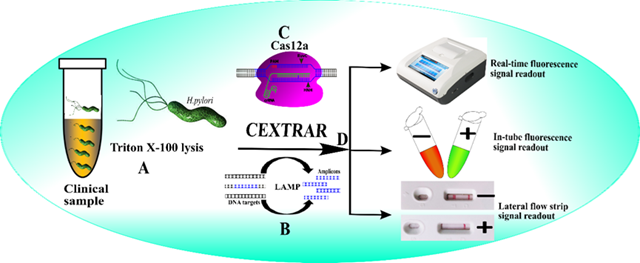Researchers Develop Highly Sensitive and Specific CRISPR/Cas12a-based Detection Method for Helicobacter Pylori
Prof. LI Zhiyuan’s group at Guangzhou Institutes of Biomedicine and Health, Chinese Academy of Sciences proposed a novel method for the ultrasensitive and specific detection of the highly pathogenic helicobacter pylori (H. pylori) strains through LAMP (loop-mediated isothermal amplification) combined with the latest CRISPR/Cas12a technology. The method can quickly and accurately detect patients who are positive for H. pylori by simply testing a saliva sample.
This study was published in Biosensors and Bioelectronics.
H. pylori infection is the main pathogenic factor of chronic gastritis and peptic ulcer, and is closely associated with gastric cancer, gastric mucosa-associated lymphoid tissue (MALT) lymphoma. It has been listed as cause classification I carcinogen to humans by the International Association of Cancer Registries (IACR). Most H. pylori-infected patients are almost asymptomatic in the early stage, which is easy to be ignored. In addition, not all H. pylori-infected people develop disease, only strains that express the cytotoxin-associated protein (CagA) and vacuolar toxin (VacA) are associated with related diseases. Therefore, a rapid, accurate, highly specific and sensitive field detection method for H. pylori, targeting CagA and VacA, is urgently needed in clinical practice.
However, current H. pylori detection methods have obvious shortcomings, which affect their popularization and application.
In contrast, in this study, the LAMP technique used by LI Zhiyuan's team has been shown to be more sensitive (100 times) than PCR, and results can be obtained quickly using a simple water bath at a constant temperature (65℃). In addition, the combination of CRISPR/Cas technology can further improve the detection sensitivity, reduce non-specific amplification, and facilitate field application in limited resource locations. Specifically, this method (named CEXTRAR for simplicity) significantly improves the trans-cleavage activity of LbCas12a by using a novel optimized extended single-stranded DNA reporter and novel buffer system, and improves the detection sensitivity by 16 times. CEXTRAR can successfully and sensitively detect CagA and VacA genes in clinical saliva samples using three methods: real-time fluorescence monitoring (43 aM and 96 aM), in-tube fluorescence colorimetric visualization (430 aM and 960 aM), and lateral flow readout (4.3 aM and 9.6 aM). Comparing with the conventional 13C-urea breath test and PCR, CEXTRAR can unmask false negative results of 13C-urea breath test.
Thus, this detection method is simple, rapid, and has higher sensitivity and specificity than the traditional methods. Its application will play an important role in the detection and tracking of the highly pathogenic H. pylori in the general population, as well as in the occurrence and improvement of prognosis of related diseases such as gastritis, gastric ulcer, and gastric cancer.
This work was financially supported by Hunan province Key R&D Plan, Hunan Provincial Natural Science Foundation and Guangdong Provincial Natural Science Foundation.

Working diagram of CEXTRAR platform for real-time fluorescence and colorimetric monitoring of H. pylori (Image by GIBH)
Contacts:
LI Zhiyuan,Ph.D, Principal Investigator;
HUANG Rongqi, Ph.D
Guangzhou Institutes of Biomedicine and Health, Chinese Academy of Sciences
Guangzhou, China, 510530
Email: li_zhiyuan@gibh.ac.cn; huang_rongqi@gibh.ac.cn